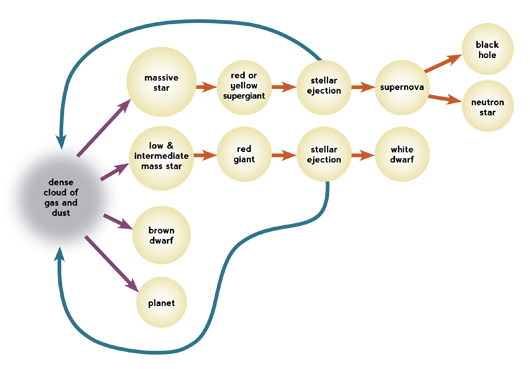Difference between revisions of "StarFormationInMW"
| (6 intermediate revisions by the same user not shown) | |||
| Line 1: | Line 1: | ||
| + | |||
| + | |||
| + | '''Star Formation is a key phenomena that determines the chemical, dynamical evolution and structure of galaxies.''' | ||
Star formation has been ongoing in the Milky Way for most of its life (>10 Billion years). | Star formation has been ongoing in the Milky Way for most of its life (>10 Billion years). | ||
| Line 10: | Line 13: | ||
[http://arxiv.org/pdf/0907.0415v1.pdf One review of the star formation history (very technical)] | [http://arxiv.org/pdf/0907.0415v1.pdf One review of the star formation history (very technical)] | ||
| + | |||
| + | |||
| + | ===Life cycles of Stars=== | ||
| + | |||
| + | [[File:diagram_lifecycle.jpg]] | ||
| + | [http://www.amnh.org/education/resources/rfl/web/starsguide/life-cycle.html Image taken from American Natural History Museum] | ||
===Learning Points=== | ===Learning Points=== | ||
* What is Metallicity? What does it tell us? | * What is Metallicity? What does it tell us? | ||
| − | * Where are the | + | * Where are the oldest stars in the Milky Way? |
* Where are the youngest stars in the Milky Way? | * Where are the youngest stars in the Milky Way? | ||
| + | * Where is the bulk of the gas and dust in the Milky Way? | ||
| + | * What will our Galaxy consist of, 1 Trillion years from now? | ||
Latest revision as of 22:24, 31 January 2013
Star Formation is a key phenomena that determines the chemical, dynamical evolution and structure of galaxies.
Star formation has been ongoing in the Milky Way for most of its life (>10 Billion years). Present day star formation occurs in the disk of the Milky Way, with some recent evidence of ongoing activity in the central part of the Galaxy.
As stars form, age, evolve they bring fundamental changes in the composition and structure of the Galaxy. The star formation process exhausts the local gas and dust, turning it into stars. For the most part, the gas and dust is effectively "locked" into low mass stars which continue to exist for Billions of years, or cool off as low-mass brown dwarfs for eternity. Higher mass objects re-release some of the gas and dust in ejecta, winds or supernovae.
Star Formation History Links
Contains an overview of a number of item, including the stars, gas, dust cycle
One review of the star formation history (very technical)
Life cycles of Stars
 Image taken from American Natural History Museum
Image taken from American Natural History Museum
Learning Points
- What is Metallicity? What does it tell us?
- Where are the oldest stars in the Milky Way?
- Where are the youngest stars in the Milky Way?
- Where is the bulk of the gas and dust in the Milky Way?
- What will our Galaxy consist of, 1 Trillion years from now?